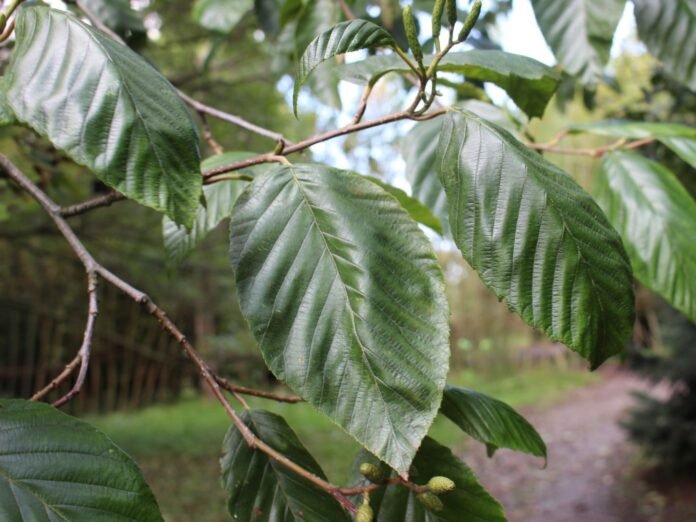Also known as: Andes Alder, Alder or Alnus
Family: Betulaceae
Origin: Southern Mexico through Argentina, Bolivia, Costa Rica, Ecuador, Guatemala, Peru into Chile . . . but being a bit more specific, its three subspecies originate, in the higher altitudes, as follow: acuminate, from Colombia and Venezuela south to northern Argentina; argute, from northwestern Mexico south to Panama; and glabrata, found in central and southern Mexico. None, apparently, proliferates near or around Northern Alaska nor the eastern stretches of Siberia! Its family name, Alnus, is the classical Latin name of Alder. The species-specific name acuminata means ‘sharp pointed’, coming from the Latin word acuminare, meaning “to make sharp”.
Going starkers or, perhaps, “Doing the full monty” (as my British friends might say) annually, as a leaf-shedding tree, these Alders are rapid growers, reaching heights of up to over eighty feet, and are quite capable of even surviving in diverse conditions, including Mother Earth’s drier dirt. Their straight trunk can thicken up to 60 inches.
I seldom quote sources so extensively, but what follows was concise, directly stated, and informative, so I shall do the same in this case. It is according to Agroforestree database (Yes, I agree, there should be another ‘t’ in that word!): “The bark is light grey or silvery with yellowish lenticels. Crown shape is rounded to pyramidal. Leaves simple, alternate, elliptical, 6-15 cm long, 3-8 cm wide, border double dentate (having a tooth-like or serrated edge), deciduous or semi-deciduous. The upper leaf surface is dark green and the lower surface (is) pale, whitish to light green. (Its) inflorescence (is) conelike with lignified scales, dark brown when ripened and bear(s) more than 100 fruits per cone. Male and female flowers occur on different catkins (flowering spike) on the same branch (with) fruit being small, membranous samara (dried/winged), 2 to 3 mm long, 1-seeded.”
This source continues its terse description with “(It prefers to grow) in moist soil, usually along the banks of streams, rivers, ponds, and swamps, where it forms dense, pure stands; can also be associated with floodplains or moist mountain slopes, (though) it may be adapted to somewhat drier conditions.
However, it is usually restricted to zones with extra soil moisture, such as cool, tropical highlands and cool, high-latitude regions with abundant rainfall.
Friendly, helpful sorts (well, as trees go!), they form symbiotic relationships with nitrogen-fixing bacteria and mycorrhizal fungi in their root nodules, thus improving soil fertility – as well as playing an active conservation role and effectively assisting with erosion control.
Andean Alders are also employed in agroforestry – described by the USDA as “the intentional integration of trees and shrubs into crop and animal farming systems to create environmental, economic and social benefits.”
Lastly, as well discussed in an interesting article found in Science Digest, entitled “Evaluation of Andean Alder as a catalyst for the recovery of tropical cloud forests in Colombia,” it is a tree species often used in revegetation programs, inasmuch as its wind-dispersed seeds germinate rapidly, then growing, in fast fashion, up to twenty-five feet in the first two years.
As to further “people purposes,” its medium-weight, somewhat soft, wood is easy with which to work, thus quite suitable for use in cabinetry, carving, decorative veneer, general construction, flooring, furniture, matchsticks, millwork, packaging, pallets, particle board, pencils, plywood, toys, pulp, and turnery. (When was the last time you used that word?). In the “wood world,” it is known for its dimensional stability. This means that it will resist warping, shrinking, and swelling, remaining functional and fit for its intended purpose. Lastly, with the appropriate techniques, a good-quality paper can be produced from this wood.
I’ve read that the Mexican Indigenous Otomí people, who have resided in central Mexico in and around the Sierra Madre Mountains (with a history stretching back to around 8,000 BC) have long used it medicinally. It was used to treat fever by boiling the fruits, leaves, and bark, and then bathing the lower half of the body with the resulting water.
The latter two parts of the tree are also used for joint and muscular pains, rheumatism, and skin infections, as well as acting as an anti-inflammatory. As a poultice, it is used to wash wounds, and through leaf infusion, it is part of a cure for prostate inflammation.
The bark is rich in tannins, thus providing treatment for skin and venereal diseases. Its fruit extracts are said to help with throat inflammation.


